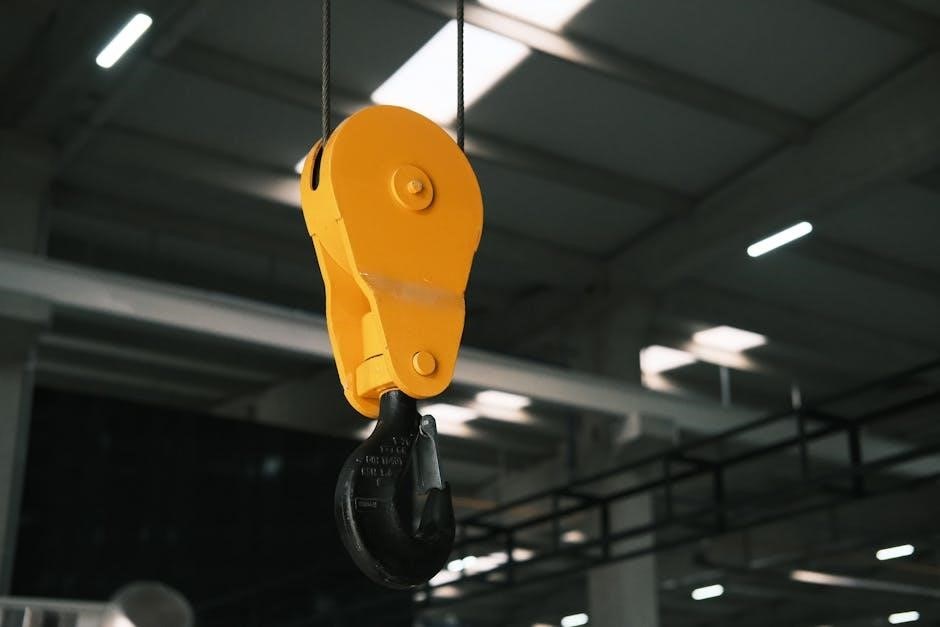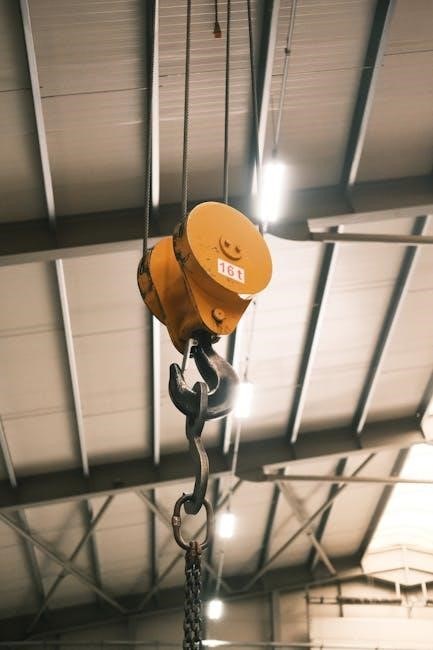
ceiling fan height guide
Proper ceiling fan height ensures safety, efficiency, and optimal airflow. This guide helps determine the ideal height based on room dimensions, ceiling height, and fan size for maximum comfort and performance.
Importance of Proper Ceiling Fan Height
Proper ceiling fan height is crucial for safety, efficiency, and optimal airflow. Installing a fan too low can pose safety risks, while too high reduces airflow effectiveness. Ensuring the fan blades are at least 7 feet above the floor minimizes accidents and enhances air circulation. Correct height also improves energy efficiency, reducing energy costs. Additionally, proper installation prevents wobbling and noise, ensuring a stable and comfortable operation in any room.

Overview of Key Considerations for Fan Installation
When installing a ceiling fan, key considerations include room dimensions, ceiling height, and fan size; Ensuring proper blade clearance from the ceiling and walls is essential for safety and efficiency. The fan should be mounted at least 7 feet above the floor and 18 inches from walls to prevent accidents and optimize airflow. Additionally, blade spacing from the ceiling and fan balance are critical for stable operation and energy efficiency.

Factors Determining Ideal Ceiling Fan Height
Ceiling fan height depends on safety clearances, room dimensions, and fan size. Proper blade spacing and mounting ensure optimal airflow while maintaining stability and efficiency.
Safety and Minimum Clearance Requirements
For safety, ceiling fan blades must be at least 7 feet above the floor to prevent accidents. Additionally, they should be 18 inches away from walls and obstructions. Proper clearance ensures optimal airflow and reduces the risk of damage or injury. Blades should also be spaced 8-10 inches from the ceiling to minimize wobbling. These clearances are crucial for both safety and performance, especially in rooms with higher ceilings requiring longer downrods.
Room Dimensions and Ceiling Height
Room dimensions and ceiling height play a significant role in determining the ideal fan height. For standard ceilings (8-9 feet), fans should be installed 8-9 feet above the floor. In rooms with higher ceilings (above 9 feet), longer downrods may be necessary to maintain optimal airflow. Conversely, lower ceilings (below 8 feet) may require flush-mount fans to ensure proper clearance and performance while maintaining safety standards for blade placement and operation.
Fan Size and Blade Span
Fan size and blade span significantly influence height adjustments. A larger blade span improves airflow but may require higher installation to prevent wobbling. Smaller fans are suitable for low ceilings, ensuring stability and safety. Proper sizing ensures optimal performance, balancing comfort and efficiency while adhering to safety guidelines for blade placement and clearance from the ceiling and surrounding objects.
Safety Guidelines for Ceiling Fan Installation
Ensure minimum blade height of 7 feet above the floor for safety and optimal airflow. Maintain 18 inches clearance from walls and obstructions to prevent accidents and ensure stability.
Minimum Height from Floor to Fan Blades
The minimum height from the floor to fan blades should be at least 7 feet for safety and optimal performance. This ensures proper airflow, reduces accidents, and prevents objects from interfering with the fan’s operation. Lower heights may cause safety hazards, while higher installations can maximize efficiency in rooms with taller ceilings. Always follow local regulations and manufacturer guidelines for precise measurements.
Clearance from Walls and Obstructions
Maintaining proper clearance from walls and obstructions is crucial for both safety and performance. Ceiling fans should be installed at least 18 inches away from any wall and 2 feet from obstructions to ensure smooth operation. This distance prevents blades from hitting objects, reduces wobbling, and allows for even air circulation. Proper clearance also enhances the fan’s efficiency and lifespan by minimizing potential damage.

Installing a Ceiling Fan: Step-by-Step Guide
Turn off electricity, remove old fixtures, secure the mounting plate, and install the new fan. Follow manufacturer instructions for wiring and blade attachment to ensure safety and proper function.
Measuring Ceiling Height and Room Dimensions
Measure the ceiling height from floor to ceiling using a tape measure. Note room dimensions, including length and width, to determine fan size and placement. Ensure the fan is centered for optimal airflow. For standard ceilings (8-9 feet), a downrod of 3-4 inches is typically sufficient. For higher ceilings, longer downrods may be needed to maintain proper blade height above the floor.
Selecting the Right Downrod Length
The downrod length depends on ceiling height and desired blade height above the floor. For standard ceilings (8-9 feet), a 3-4 inch downrod is typically used. Taller ceilings may require longer downrods to maintain proper blade height. Ensure the fan blades are 8-10 inches from the ceiling for optimal airflow. Downrods are available in various lengths to suit different ceiling heights and design preferences, ensuring both functionality and aesthetics.

Optimal Ceiling Fan Height for Different Rooms
Ceiling fans should be installed 8-9 feet above the floor for standard rooms, while taller ceilings may require longer downrods to maintain optimal blade height and airflow efficiency.
Standard Ceiling Heights (8-9 Feet)
For rooms with standard ceiling heights of 8-9 feet, installing a ceiling fan 8-9 feet above the floor ensures optimal airflow and safety. This height allows the fan blades to circulate air effectively, improving comfort without causing drafts. Proper installation at this height also meets safety standards, keeping blades out of reach while maximizing energy efficiency and performance.
High Ceiling Applications (Above 9 Feet)
In rooms with ceilings above 9 feet, ceiling fans should be installed 8-9 feet above the floor using an extended downrod. This setup ensures optimal airflow distribution and maintains energy efficiency. The fan blades must be at least 7 feet above the floor for safety, and the motor should operate at a height of 2.4m (7ft 10in) for optimum performance, as specified by installation guidelines.
Low Ceiling Solutions (Below 8 Feet)
For ceilings below 8 feet, flush-mount ceiling fans are recommended to maintain the minimum required blade height of 7 feet above the floor. These fans are specifically designed to be installed directly against the ceiling, ensuring safety and maximizing airflow without compromising comfort. Proper installation is crucial to prevent wobbling and ensure efficient operation in low-ceiling spaces.
Ensuring Proper Airflow and Performance
Proper ceiling fan installation ensures optimal airflow and performance by maintaining blade spacing 8-10 inches from the ceiling and mounting the fan centrally for even air distribution.
Blade Placement and Spacing from the Ceiling
Proper blade placement ensures efficient airflow and stability. Blades should be positioned 8-10 inches from the ceiling to minimize wobbling and maximize air circulation. This spacing prevents uneven air distribution and enhances motor performance, ensuring optimal comfort and energy efficiency in any room setting.
Mounting the Fan in the Center of the Room
Mounting the fan in the center ensures balanced airflow and optimal coverage. Position the fan at least 18 inches from walls and obstructions to prevent turbulent air pockets. Central placement maximizes circulation, maintaining consistent temperature distribution and improving overall comfort, making it essential for effective ceiling fan performance in any room size or layout.
Maintenance and Adjustments
Regularly inspect fan balance and stability to ensure smooth operation. Adjustments may be needed for seasonal use to optimize airflow efficiency and prevent wobbling or noise issues.
Periodic Checks for Stability and Balance
Regularly check the ceiling fan’s balance and stability to ensure smooth operation. Tighten any loose screws and verify blade alignment to prevent wobbling or noise. Inspect the fan motor for proper function and address any imbalance promptly to avoid performance issues.
Check the fan’s center position in the room and ensure the downrod is securely attached. These periodic checks help maintain optimal airflow and prevent potential hazards or efficiency losses over time.
Adjusting Fan Height for Seasonal Use
Adjusting ceiling fan height seasonally optimizes airflow and energy efficiency. Lower the fan slightly in summer to enhance cooling circulation, and raise it in winter to redistribute warm air evenly. This simple adjustment ensures consistent comfort and reduces energy consumption throughout the year.
Proper ceiling fan installation and height adjustment ensure safety, efficiency, and comfort. Always follow guidelines for optimal performance and seasonal adjustments.
The ideal ceiling fan height ensures safety and optimal airflow. Blades should be 8-10 inches from the ceiling and at least 7 feet above the floor. Mounting the fan in the center of the room, 18 inches from walls, maximizes performance. Adjusting the fan height seasonally and ensuring proper blade spacing enhances efficiency and comfort. Always follow safety guidelines for installation and maintenance.
Final Tips for Maximizing Comfort and Efficiency
Adjust the fan height seasonally to optimize airflow. Use a longer downrod for high ceilings and a shorter one for standard heights. Ensure blades are 8-10 inches from the ceiling for stability. Periodically check balance and tighten screws for smooth operation. Direct airflow downward in summer and upward in winter for energy efficiency. These adjustments ensure your ceiling fan performs at its best year-round.